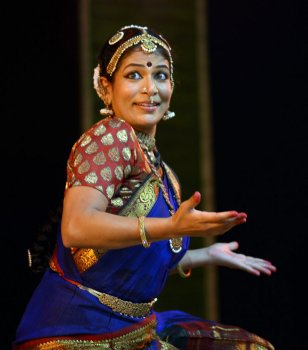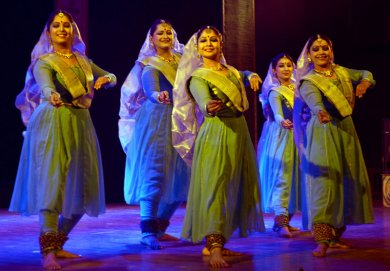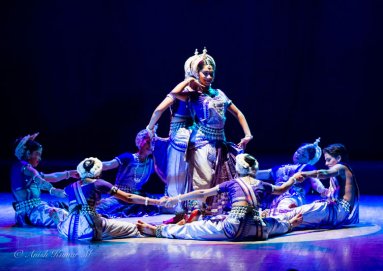
|   |

|   |
Grace and beauty of traditional dancing - Dr. M. Surya Prasad e-mail: drmsuryaprasad@gmail.com Photos courtesy: Nadam November 22, 2014 Another three day festival of dance Kala Nadam 2014 under the baton of seasoned exponents of Kathak, Nandini Mehta and Murali Mohan (who were outstanding in their performance of teental, Sudhaama and chedo na bihari) ended on Nov 9, 2014 at ADA Rangamandira, Bangalore. The Kathak-duo deserves to be commended for their gesture of not only dedicating the festival to their Guru Maya Rao who passed away recently but also for donating the proceedings of the festival to a social organization called The Environmental Foundation of India. The programs were varied, exciting and very professionally done. The modern nature of the group dancing was enhanced by the energetic performance of the dancers. The concluding evening was uniquely entertaining. The utilization of the large set pieces was artfully done and contributed well to the choreography and message. The programs were of high artistic caliber.  Divya Devaguptapu
Divya Devaguptapu from USA packed her Bharatanatya with plenty of punch and made it a very powerful performance, graceful and eloquent. Her intense but changeable emotions were exquisitely expressed. She sprung into life with Sannidhi, an invocation to god to ward off all evils (Agamaarthantudevanam). The nritta attached to it was dealt with ease. A Telugu work ‘Kunti vilapam’ by Jandyala Papaiah Sastry with Mahabharata’s Kunti’s tale as the theme turned out to be a mini dance drama. Her virtuosic flamboyancy made a compelling case for her versatility in nritta, nrithya and abhinaya. Her footwork, timing and cohesion could not be faulted. Kunti wants to test the veracity of a boon gifted to her through a mantra by Durvasa Muni to beget a child as and when she wants. She, an unwed girl, tries it before her marriage and gives birth to Karna. She is stirred by a conflict of varied emotions like fear, agony, repentance and so on. A tormented Kunti abandons the infant and blames the Sun God too. The thematic verses beginning with “Pettilona” were set to a ragamalika comprising Revathi, Kaanada, Behag and other ragas. The challenging theme was reached to the rasikas in Divya’s engrossed abhinaya. The saatwikaabhinaya, the most important element in such themes, was at its best equally well supported by soulful live music ensemble. Next came a technically fluid and electric Khamach tillana by Lalgudi Jayaraman. Her rendition captured the beauty of swaraaksharas, swaras and jathis collaborated artistically with adavus and teermanas. The concluding item, a Purandaradasa pada Haridasarada upavasada bhagyavu (Sindhubhairavi) drew instant applause. Under the banner of Nadam Ensemble, the disciples of Nandini and Murali - Smitha, Samanvitha Arpitha, Sowmya, Swati, Malavika, Thanvi, Vidyashri, Jinal, Manasa and Poorna Acharya - excelled each other in their group renditions. As expected, Lord Ganesha was saluted through Gaayiye Ganapathim. In the delineation of the taal they covered the stage in innumerous patterns. The dancers moved like a single unit creating visually pleasing designs. It was a delight to watch them presenting thaats, aamads, parans, tatkars, chakkars, tihais etc., with precision. The manner in which they reached the ‘sam’ after taking off from different points was remarkable. The pranks of Balakrishna were reenacted on the basis of Mohe chedo naa. The lyrical quality of this work was accentuated by the smooth, fluid choreography that oozed elegance due to the effortless appearance of the dancers’ movements. The strength and momentum of the performers was accentuated by a skillful blend of dynamic and static choreography. A Gujarati bhajan in praise of Lord Rama was interpreted appropriately.  Nadam Ensemble  Srjan ensemble A neo-classical innovation in Odissi dance by the Srjan ensemble made it a wonderful night of dance that showed how the human body can tell stories that resonate to the deepest levels. The creative gifts were set free in this performance that was excellent in every way. The choreographer par excellence Ratikant Mohapatra of Bhubaneswar proved that he is a meticulous master of movement, able to dazzle with the technique and mesmerize with a mystic expressiveness. The Srjan ensemble naturally prompted a burst of applause in recognition of their extreme pliancy and speed to astonishing use of the bodies and exploration of space, using characteristically the vocabulary of Odissi dance. The magnificent troupe of dancers built up a climax full of joy and abandon. Srjan shone forth as a company that exhibits exemplary talent in the development of new artistic works, enabling the community of Odissi dance to reach new aesthetic and artistic standards. The presentation of Ardhanareeshwara stotra made it a memorable evening. It was like gazing on a series of beautiful sculpted statues that had been brought to life. The half man and half woman concept of Lord Shiva had a vivid visualization. The attributes of Lord Shiva and His consort Parvathi are explicated in the stotra in turns. Filling the stage with wheeling exhilaration the dancers of Srjan showed a great deal of balance and leverage happening. Underpinning the springing, leaping choreography with its exuberantly rhythmic music the dancers also projected a strongly individual personality, precision of group alignments and realignments plus that extra flair of joy and elegance of gesture they brought to their art. The portrayal of emergence of Devi (Prapancha srushtyunmukhalasyakayai) and the moving chariot carrying the Lord (Samasta samhaaraka tandavaya) was just superb. The high-energy number with dynamic choreography had all the dancers in one section beautifully synchronized. It was a supreme collaborative performance that was practically weightless as the artistes floated through the choreography, swooping and swirling, shifting en masse to unseen stimuli. The dancers appeared and disappeared through skillful coordination of choreography and lighting. Likewise, the rendition of ‘Synthesis’ (contemporary expressions of faith) and the characterization of Kubja (the hunch backed devotee of Krishna) along with the enactment of Krishna leelas had precise timing and positioning as well as physical prowess and mental focus. Dr. M. Surya Prasad is a renowned music and dance scholar and critic. He is the regular columnist for The New Indian Express. |